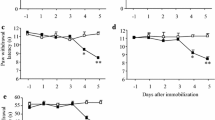Summary
Male rats received unavoidable footshock administered while either awake or under Halothane® anaesthesia. Tail-flick threshold was measured subsequently in awake rats. An elevation in pain threshold indicative of stress-induced analgesia (SIA) appeared in rats shocked while awake, but not in those shocked while anaesthetized. The findings suggest that conscious processes are necessary for the occurrence of SIA.
Similar content being viewed by others
References
Amir, S., Amit, Z.: The pituitary gland mediates acute and chronic pain responses in stressed and non-stressed rats. Life Sci.18, 1143–1152 (1978).
D'Amour, F. E., Smith, D. L.: A method for determining loss of pain sensation. J. Pharmacol. Exp. Therap.72, 74–79 (1941).
Basbaum, A. I., Marley, J. J. E., O'Keefe, J., Clanton, C. H.: Reversal of morphine and stimulus produced analgesia by subtotal spinal cord lesions. Pain3, 43–56 (1977).
Basbaum, A. I., Fields, H. L.: Endogenous pain control mechanisms: Review and hypothesis. Ann. Neurol.4, 451–462 (1978).
Bodnar, R. J., Kelly, D. D., Glusman, M.: Stress-induced analgesia: Time course of pain reflex alterations following cold water swims. Bull. Psychonom. Soc.11, 333–336 (1978).
Chance, W. T., White, A. C., Krynock, G. M., Rosecrans, J. A.: Conditioned fear-induced antinociception and decreased binding of (3H) N-Leu-enkephalin to rat brain. Brain Res.141, 371–374 (1978).
Cheney, D. L., Costa, E.: Pharmacological implications of brain acetylcholine turnover measurements in rat brain nuclei. Ann. Rev. Pharmacol. Toxicol.17, 369–386 (1977).
Chesher, G. B., Chan, B.: Footshock-induced analgesia in mice: Its reversal by naloxone and cross tolerance with morphine. Life Sci.21, 1569–1574 (1977).
Cohen, P. J., Dripps, R. D.: Signs and stages of anaesthesia. In: The Pharmacological Basis of Therapeutics (Goodman, L. S., Gilman, A. eds.), 4th ed., pp. 49–55. London: Macmillan. 1970.
Dennis, S. G., Melzack, R., Gutman, S., Boucher, F.: Pain modulation by adrenergic agents and morphine as measured by three pain tests. Life Sci.26, 1247–1259 (1980).
Hayes, R. L., Bennett, G. J., Newlon, P. G., Mayer, D. J.: Behavioral and physiological studies of non-narcotic analgesia in the rat elicited by certain environmental stimuli. Brain Res.155, 69–90 (1978).
Hayes, R. L., Price, D. D., Bennett, G. J., Wilcox, G. L., Mayer, D. J.: Differential effects of spinal cord lesions on narcotic and non-narcotic suppression of nociceptive reflexes: Further evidence for the physiological multiplicity of pain modulation. Brain Res.155, 91–100 (1978).
Irwin, S., Houde, R. W., Bennett, D. R., Henderskot, L. C., Seevers, M. H.: The effects of morphine, methadone and meperidine on some reflex responses of spinal animals to nociceptive stimulation. J. Pharmacol. Exp. Therap.101, 132–143 (1951).
Lewis, J. W., Cannon, J. T., Liebeskind, J. C.: Opioid and non opioid mechanisms of stress analgesia. Science208, 623–625 (1980).
Madden, J., Akil, H., Patrick, R. L., Barchas, J. D.: Stress induced parallel changes in central opioid levels and pain responsiveness in the rat. Nature (Lond.)265, 358–360 (1977).
Mayer, D. J.: Endogenous analgesia systems: Neural and behavioral mechanisms. In: Advances in Pain Research and Therapy, Vol. 3 (Bonica, J. J. et al, eds.), pp. 385–410. New York: Raven Press. 1979.
Melzack, R., Casey, K. L.: Sensory motivational and central control determinants of pain. In: The Skin Senses (Kenshalo, D. R., ed.), pp. 423–443. Springfield, Ill.: Ch. C Thomas. 1968.
Millan, M. J., Przewlocki, R., Herz, A.: A non-β-endorphinergic adenohypophyseal mechanism is essential for an analgetic response to stress. Pain8, 343–353 (1980).
Routledge, P. A., Shand, D. G.: Presystemic drug elimination. Ann. Rev. Pharmacol. Toxicol.19, 447–468 (1979).
Winters, W. D.: Effects of drugs on the electrical activity of the brain: Anesthetics. Ann. Rev. Pharmacol. Toxicol.16, 413–426 (1976).
Author information
Authors and Affiliations
Rights and permissions
About this article
Cite this article
Jensen, T.S., Smith, D.F. The role of consciousness in stress-induced analgesia. J. Neural Transmission 52, 55–60 (1981). https://doi.org/10.1007/BF01253097
Received:
Issue Date:
DOI: https://doi.org/10.1007/BF01253097




